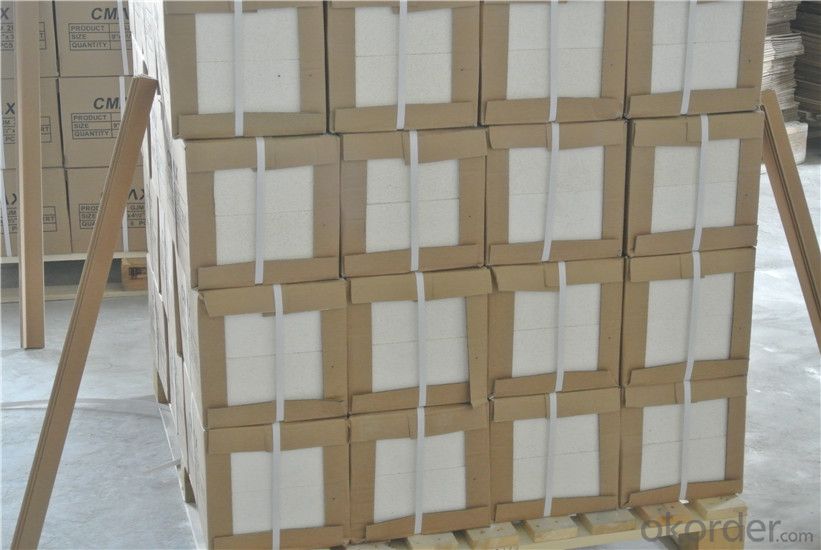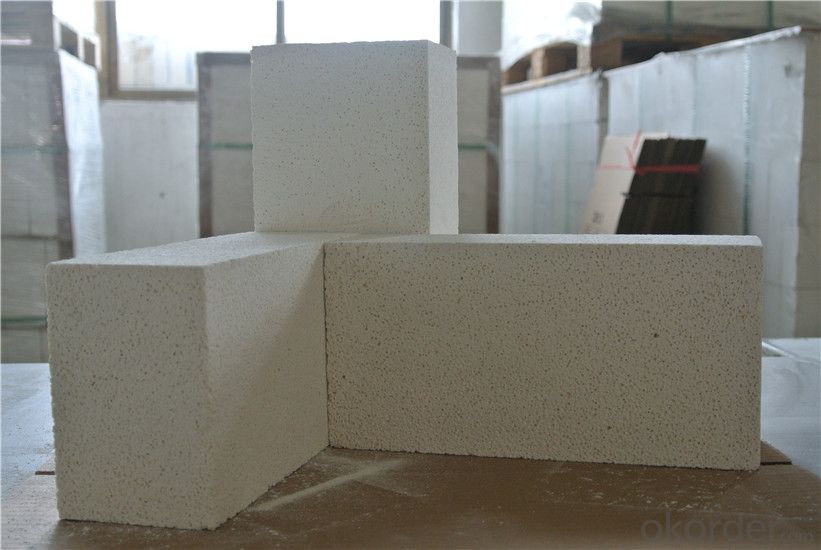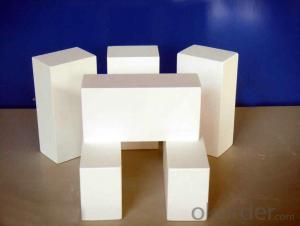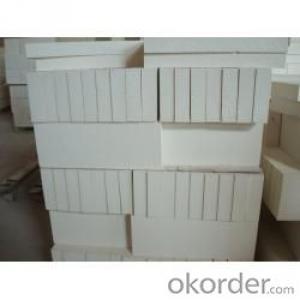DJM 26 Light Weight Insulating Fire Brick
- Loading Port:
- Tianjin
- Payment Terms:
- TT OR LC
- Min Order Qty:
- 1 m.t.
- Supply Capability:
- 1000 m.t./month
OKorder Service Pledge
OKorder Financial Service
You Might Also Like
Thermal Insulation Fire Clay Brick
DJM 26 Light Weight Insulating fire brickconforms strictly to the requirements of ISO 9000 quality control system during the production. MSDS is also available if you want. The thermal insulation fire clay brick meet with the requirements of ASTM & JIS standards. So please stay cool with our quality.
Application
DJM 26 Light Weight Insulating fire brick are used for the lining of converter, alternating current arc furnace, direct Current arc furnace and the ladle slag line, etc.
Company Advantage
(1)Long Insulating Fire Brick manufacture history: 25 years manufacturer
(2)Advanced equipment
(3)Diversification of production standards: ISO ANSI FEPA JIS ASTM
(4)Flexible payment: T/T L/C D/P D/A
(5)Professional marketing team and after-sale service
(6)Free sample
Equipment
1 unit of Ceramic Abrasive (SG Abrasive) pilot production line
1 unit of high-end coated abrasives (abrasive cloth) production line
2 units of Boron Carbide production lines
Q1 What’s the transport method?
A1 FCL delivery goods with wooden pallet or wooden case by sea; If LCL delivery, must with wooden case; Sometimes need open top, flat rack or bulk cargo.
Q2 What’s the required payment term?
A2 Generally 30% TT as the prepayment, 70% TT before delivery. If need, 100% Irrevocable Letter of Credit or negotiation.
Q3 Which country are our products exported to?
A3 Apart from entire Chinese market, the US, Russia, Japan, Korea, Australia and some Southeast Asian Nations.


- Q:Are insulating fire bricks suitable for use in autoclaves?
- Insulating fire bricks are not typically suitable for use in autoclaves. Autoclaves are high-temperature and high-pressure environments used for various applications such as sterilization, curing, and material testing. The insulating fire bricks are designed to have low thermal conductivity and are primarily used to provide insulation and reduce heat loss in applications where high temperatures are involved. In autoclaves, the environment requires materials that can withstand both high temperatures and high pressures. Insulating fire bricks are not designed to handle the high pressures typically found in autoclaves, and using them in such environments may result in structural failure or damage. For autoclave applications, it is recommended to use refractory bricks or materials specifically designed for high-temperature and high-pressure conditions. These materials are engineered to withstand the extreme conditions inside an autoclave, ensuring safety and longevity of the equipment.
- Q:Can insulating fire bricks be used for insulation in sewage treatment plants?
- Yes, insulating fire bricks can be used for insulation in sewage treatment plants. These bricks are designed to withstand high temperatures and provide excellent thermal insulation. They can be used to line the walls, floors, and ceilings of sewage treatment plants to reduce heat loss and improve energy efficiency. Additionally, insulating fire bricks have good resistance to chemicals and moisture, making them ideal for use in environments with high levels of humidity and corrosive substances found in sewage treatment plants.
- Q:Can insulating fire bricks be cut or shaped to fit specific dimensions?
- Yes, insulating fire bricks can be cut or shaped to fit specific dimensions. These bricks are made from lightweight refractory materials and are designed to be easily cut or shaped to meet specific requirements. They can be cut using a saw, knife, or other cutting tools, and can also be shaped by grinding or sanding. This flexibility allows for precise customization of the bricks to fit specific dimensions, making them a versatile option for various applications such as lining furnaces, kilns, and other high-temperature environments.
- Q:Can insulating fire bricks be used for pizza ovens?
- Indeed, pizza ovens can make use of insulating fire bricks. These bricks have been specifically crafted to endure extreme heat and offer exceptional insulation, positioning them as an optimal selection for pizza ovens. By possessing low thermal conductivity, insulating fire bricks excel at retaining heat for extended durations, guaranteeing that your pizza is evenly and efficiently cooked. Moreover, their lightweight composition allows for effortless handling and installation in a pizza oven. Ultimately, the utilization of insulating fire bricks within a pizza oven can effectively uphold high temperatures, diminish heat loss, and enhance the overall cooking proficiency.
- Q:Can insulating fire bricks be used in high-temperature insulation for cryogenic applications?
- Insulating fire bricks do not meet the requirements for high-temperature insulation in cryogenic applications. They are specifically designed to endure temperatures up to approximately 2300°F (1260°C), which falls significantly below the extremely low temperatures necessary for cryogenic applications. Cryogenic temperatures typically span from -150°C to -273°C (-238°F to -459°F), and insulating fire bricks lack the capability to offer sufficient insulation under these conditions. Instead, cryogenic insulation commonly relies on specialized materials like aerogels or multi-layered insulation systems to guarantee minimal heat transfer and sustain the extremely low temperatures demanded.
- Q:Are insulating fire bricks resistant to hydrofluoric acid?
- Hydrofluoric acid is a highly corrosive substance capable of attacking and dissolving various materials, including fire bricks, which lack resistance to it. Therefore, it is crucial to exercise utmost caution and employ suitable protective gear while dealing with this hazardous substance.
- Q:Can insulating fire bricks be used for insulation in solar thermal systems?
- Yes, insulating fire bricks can be used for insulation in solar thermal systems. Insulating fire bricks are specially designed to have low thermal conductivity, which means they can effectively trap and retain heat. This makes them suitable for insulating the components of a solar thermal system, such as the solar collector and the storage tank, to minimize heat loss and increase the overall efficiency of the system. Additionally, insulating fire bricks are able to withstand high temperatures, which is crucial in solar thermal systems where temperatures can reach extremes. Overall, using insulating fire bricks for insulation in solar thermal systems can help improve their performance and reduce energy loss.
- Q:Can insulating fire bricks be used for insulation in heat treatment furnaces?
- Yes, insulating fire bricks can be used for insulation in heat treatment furnaces. Insulating fire bricks are designed to handle high temperatures and provide excellent thermal insulation, making them suitable for use in heat treatment furnaces where maintaining a consistent and controlled temperature is crucial.
- Q:Do insulating fire bricks require any special installation techniques?
- Special installation techniques are necessary for insulating fire bricks. These bricks are designed to offer excellent thermal insulation, so proper installation is essential for optimal performance. To begin, it is crucial to have a clean and debris-free installation surface. This creates a strong and stable foundation for the bricks. Afterward, it is important to use a suitable refractory mortar or adhesive to secure the bricks in place. This mortar should be specifically designed for high-temperature applications and capable of withstanding thermal expansion and contraction during heating and cooling cycles. During installation, attention should be given to filling the joints between the bricks with mortar. This prevents heat loss and maintains the insulating properties of the bricks. Furthermore, careful stacking and alignment of the insulating fire bricks is necessary to ensure a tight fit and minimize gaps. This maximizes insulation and prevents heat leakage. Lastly, it is advisable to consult the manufacturer's guidelines and follow their recommended installation techniques. Different types of insulating fire bricks may have specific requirements that must be adhered to for proper installation. In summary, insulating fire bricks demand special installation techniques to ensure their effectiveness and longevity. Following proper installation practices will enhance the thermal insulation properties of these bricks and optimize their performance.
- Q:Can insulating fire bricks be used in the construction of incineration kilns?
- Yes, insulating fire bricks can be used in the construction of incineration kilns. Insulating fire bricks are designed to have excellent thermal insulation properties, which make them ideal for applications where high temperatures are encountered, such as incineration kilns. These bricks are capable of withstanding extreme temperatures and offer insulation to minimize heat loss, resulting in improved energy efficiency and reduced fuel consumption. Additionally, insulating fire bricks are lightweight, easy to handle, and can be easily shaped and installed in various configurations, making them suitable for constructing the complex geometries often found in incineration kilns. Overall, using insulating fire bricks in the construction of incineration kilns can enhance their thermal performance, increase their durability, and contribute to more efficient and effective waste management processes.
1. Manufacturer Overview |
|
|---|---|
| Location | |
| Year Established | |
| Annual Output Value | |
| Main Markets | |
| Company Certifications | |
2. Manufacturer Certificates |
|
|---|---|
| a) Certification Name | |
| Range | |
| Reference | |
| Validity Period | |
3. Manufacturer Capability |
|
|---|---|
| a)Trade Capacity | |
| Nearest Port | |
| Export Percentage | |
| No.of Employees in Trade Department | |
| Language Spoken: | |
| b)Factory Information | |
| Factory Size: | |
| No. of Production Lines | |
| Contract Manufacturing | |
| Product Price Range | |
Send your message to us
DJM 26 Light Weight Insulating Fire Brick
- Loading Port:
- Tianjin
- Payment Terms:
- TT OR LC
- Min Order Qty:
- 1 m.t.
- Supply Capability:
- 1000 m.t./month
OKorder Service Pledge
OKorder Financial Service
Similar products
New products
Hot products
Related keywords



























